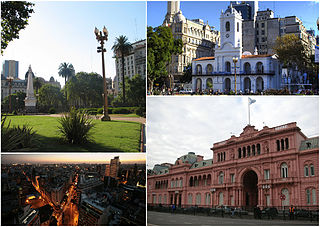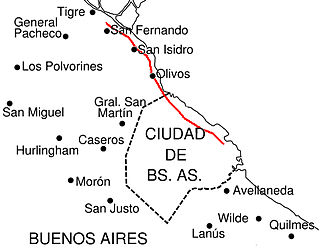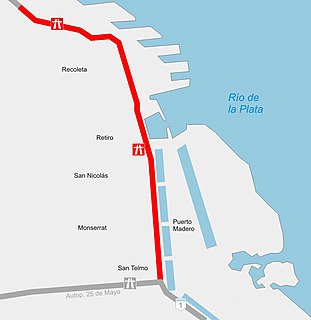
Balvanera is a barrio or neighborhood of Buenos Aires, Argentina.

Palermo is a barrio or neighborhood of Buenos Aires, Argentina. It is located in the north of the city, near the Rio de la Plata.

Recoleta is a barrio or neighborhood of Buenos Aires, Argentina, located in the northern part of the city, by the Río de la Plata. The area is perhaps best known to be the home of the distinguished Recoleta Cemetery. It is also relatively affluent, with some of the priciest real estate in the city.

Almagro is a mostly middle-class barrio or neighbourhood of Buenos Aires, Argentina.

Retiro is a barrio or neighborhood in Buenos Aires, Argentina. Located in the northeast end of the city, Retiro is bordered on the south by the Puerto Madero and San Nicolás, and on the west by the Recoleta.

Avenida Corrientes is one of the principal thoroughfares of the Argentine capital of Buenos Aires. The street is intimately tied to the tango and the porteño sense of identity. Like the parallel avenues Santa Fe, Córdoba, and San Juan, it takes its name from one of the Provinces of Argentina.

Buenos Aires is in the midst of a tourism boom, according to the World Travel & Tourism Council, which reveals strong growth for Argentina Travel and Tourism in 2007 and in coming years, and the prestigious travel and tourism publication; Travel + Leisure, a monthly magazine, travelers voted Buenos Aires the second most desirable city to visit after Florence, Italy. Buenos Aires, regarded as the “Paris of South America”, offers elegant architecture, exquisite cuisine, a legendary nightlife, and fashionable shopping. Argentina has become famous for its rich European flavor.

Barrio Norte is the informal name given to a part of Buenos Aires centering on Santa Fe Avenue and the district of Recoleta.

The Maldonado Stream is an underground storm sewer in the city Buenos Aires, Argentina, that runs below Juan B. Justo Avenue. Originally a stream draining into the Río de la Plata, its 21.3 kilometres (13.2 mi) length goes through 10 of the 47 barrios of the city: Versalles, Liniers, Villa Luro, Vélez Sarsfield, Floresta, Villa Santa Rita, Villa Mitre, Caballito, Villa Crespo, and Palermo.

The colectivo 64 is a bus line of Buenos Aires, Argentina, that goes through the neighbourhoods of La Boca, San Telmo, Monserrat, San Nicolás, Balvanera, Recoleta, Palermo and Belgrano.

Monserrat in the simplified Spanish spelling or, originally, Montserrat is a neighbourhood in the east of the Buenos Aires CBD. The district features some of the most important public buildings in Buenos Aires, including city hall, the city legislature, Casa Rosada, the Colegio Nacional de Buenos Aires and the Libertador Building, among others.
There are a number of major football rivalries in Argentina.

Avenida del Libertador is one of the principal thoroughfares in Buenos Aires, Argentina, and in points north, extending 25 km (16 mi) from the Retiro District of Buenos Aires to the northern suburb of San Fernando.

Avenida Santa Fe is one of the principal thoroughfares in Buenos Aires, Argentina. The artery is essential to the imaginary axis of Barrio Norte in Buenos Aires, comprising the areas influenced by the route of the avenue through Retiro, Recoleta and Palermo neighborhoods, it is considered one of the main shopping and strolling areas of the city, its many boutiques range from elegant to edgy, which has led it to be dubbed the 'Avenue of Fashion'. Upscale Alto Palermo, at Avenida Coronel Díaz, is one of the city's best-known vertical malls. Avenida Santa Fe is also an attraction for its architecture, strongly reminiscent of Paris. Its name pays homage to the eponymous province in Argentina.

Córdoba Avenue is one of the principal thoroughfares in Buenos Aires, Argentina.

Agüero Street is an artery road of the City of Buenos Aires and crosses the neighborhoods of Recoleta and Balvanera.

The city of Buenos Aires is administratively divided into fifteen comunas, unlike the rest of Argentina where the second order administrative division is departamentos, or the Province of Buenos Aires which is subdivided into partidos. Each comuna (commune) of the city encompasses one or more neighbourhoods (barrios), which are represented in the respective community centres for administrative purposes.

Saldías is a railway station located at the boundary between the Recoleta and Palermo barrios of Buenos Aires, Argentina. The station is part of Belgrano Norte Line, between Retiro and Ciudad Universitaria stations. It is currently operated by both companies, private Ferrovías and state-owned Trenes Argentinos. The station is named after Argentinian historian, lawyer, politician, soldier and diplomat Adolfo Saldías.

Paseo del Bajo, officially named Brigadier General Juan Manuel de Rosas, is a highway in the city of Buenos Aires, Argentina. It joins the 25 de Mayo, Arturo Illia and Buenos Aires-La Plata highways. It has a length of 7.1 km (4 mi) with two lanes on each direction.


















